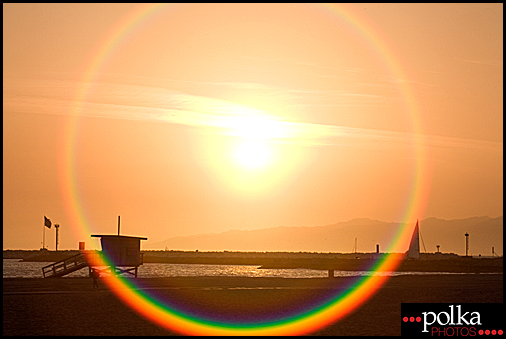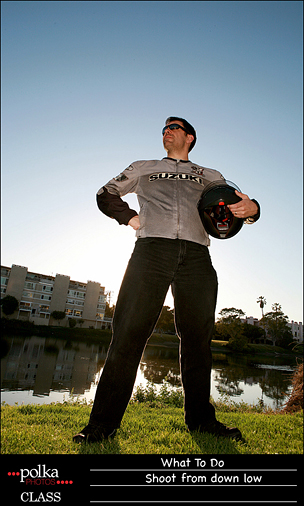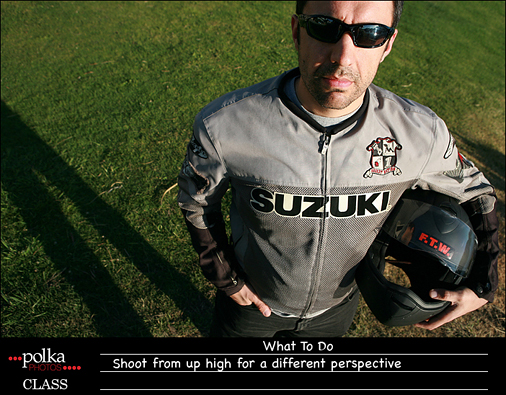Playa del Rey, California
A lone sailboat glides into the marina at sunset with the cliffs of Malibu visible in the distance. This is the northwesternmost point in Playa, nicknamed Toes Over Beach back when it was a good surfing spot.


|
As some of you may have heard, Polish President Lech Kaczynski, along with his wife, other Polish officials and war veterans, died in a plane crash in western Russia. They were on their way to a mass commemorating the 70th anniversary of the Katyn Massacre, during which thousands of Polish prisoners of war were murdered by the Russians. May they all rest in peace. There will be a memorial mass tonight at Our Lady of the Bright Mount Catholic Church at 3424 West Adams Blvd in Los Angeles. The first ever online Polka Photos Class is full. But you can still follow along on the blog. Composition Lesson 2: Viewpoint
This week’s assignment is to change your viewpoint. Usually the most flattering photos of people are taken either at their eye level or a little above. If you take a lot of photos of your kids or pets from your height, I recommend getting down to their level. Another option is to get down super low. Don’t be afraid to lie down on the ground. Looking up at your subject makes her or him look dominant, strong. It can also make your pint-size appear like a giant, or a flower look as tall as a tree. Another thing to remember is that the camera emphasizes what’s in the foreground. So if you’re really close to someone’s foot, especially with a wide-angle lens, it’s going to appear bigger than his head! The third option is a higher vantage point. This can be a roof, stairs, chairs or even a ladder (just be careful and have a spotter for the last two). And sometimes you just need to stand tall on your own two feet and point the camera down. Again, whatever is in your foreground will appear larger than the background. Since most of the time you probably take eye-level photos, for this week’s assignment shoot from either a really low or really high viewpoint. Here are my sample shots. Michael was coerced, I mean volunteered, to model again. This is what I call the superhero pose. Since I backlit the subject, I used flash as my main light source on Michael so he wouldn’t be silhouetted. My max sync speed is 200 so I had to use a higher f-stop. This meant the background would be more in focus than ideally I’d like, but it doesn’t distract me from the subject.         Playa Vista, California
I was out and about taking some photos early in the morning for my Postcards from Playa series when I heard some rustling in the grass. This close to Easter, could it be the elusive Leporidae Chocolataea? I crouched down low with my camera and managed to snap one photo before he hopped away. Happy Easter!!!
  The first ever online Polka Photos Class is full. But you can still follow along on the blog. I’ll be posting the lessons every Thursday for the next 5 weeks. The class lesson does have a few more tips and tricks. So if you’re interested in the next online class let me know by emailing class@polkaphotos.com. Composition Lesson 1: Simplification Composition is the way you arrange the elements in a photo or other work of art. There are many rules to composition. I prefer to call them guidelines or ideas since some of the best photos break these rules. The first idea may seem easy, but it’s often the most overlooked when shooting snapshots. What exactly is simplification? Simplification is reducing visual clutter. The first thing you need to decide when taking a photo is what is your subject. Your subject can be a baby, playing kids, a flower, a building. Once you decide on your subject, look at the background. Sometimes you can move your subject to a better background, sometimes you can’t. If you can’t move your subject, you can move to find the best background. Are you taking a photo of someone and they have a tree sticking straight out of their head? Just move. Another way to simplify that is often overlooked is to get closer. For the purposes of this exercise, don’t use your zoom to get closer. Move yourself closer to your subject.
So
    |
|